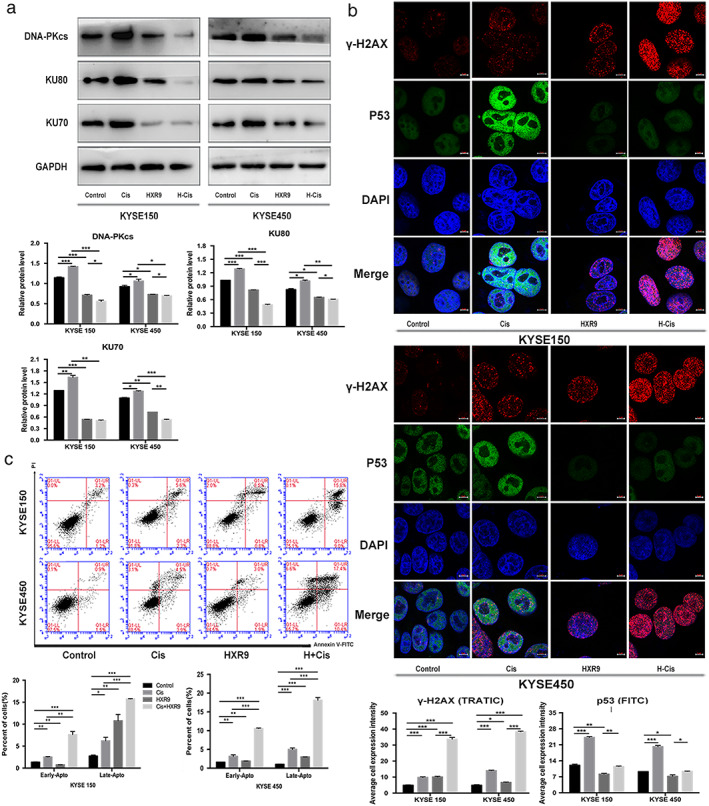Figure 8.

HXR9 reinforced the effects of cisplatin to induce DNA damage and cell apoptosis. (a) Ku70, Ku80, DNA‐PKcs expression was downregulated in HXR9‐treated cells. Combination of HXR9(10 μM) and cisplatin (2 μg/mL for KYSE150 and 1 μg/mL for KYSE450) significantly declined Ku70, Ku80, DNA‐PKcs expression compared to single agent. ( ) Control, (
) Control, ( ) Cis, (
) Cis, ( ) HXR9, and (
) HXR9, and ( ) H+Cis. (b) HXR9 reinforced the effects of cisplatin to induce DNA damage as presented by stronger γ‐H2AX fluorescence intensity. However, HXR9 weakened the effect of cisplatin to activate DNA damage response as presented by attenuated P53 fluorescence intensity. (
) H+Cis. (b) HXR9 reinforced the effects of cisplatin to induce DNA damage as presented by stronger γ‐H2AX fluorescence intensity. However, HXR9 weakened the effect of cisplatin to activate DNA damage response as presented by attenuated P53 fluorescence intensity. ( ) Control, (
) Control, ( ) Cis, (
) Cis, ( ) HXR9, and (
) HXR9, and ( ) H+Cis. (c) Combination of HXR9 and cisplatin induced more cell apoptosis. Cells were treated with the indicated concentration of cisplatin (2 μg/mL for KYSE150 and 1 μg/mL for KYSE450), HXR9 (10 μM) or combination of HXR9(10 μM) and cisplatin (2 μg/mL for KYSE150 and 1 μg/mL for KYSE450) for 24 hours, and then underwent flow cytometry analysis by staining with Annexin V/PE. This experiment was performed thrice in triplicates.
) H+Cis. (c) Combination of HXR9 and cisplatin induced more cell apoptosis. Cells were treated with the indicated concentration of cisplatin (2 μg/mL for KYSE150 and 1 μg/mL for KYSE450), HXR9 (10 μM) or combination of HXR9(10 μM) and cisplatin (2 μg/mL for KYSE150 and 1 μg/mL for KYSE450) for 24 hours, and then underwent flow cytometry analysis by staining with Annexin V/PE. This experiment was performed thrice in triplicates.
